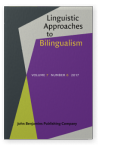Commentary
The relevance of L1 attrition to usage-based theories of language development
References (9)
References
Anderson, M. C., & Spellman, B. A. (1995). On the status of inhibitory mechanisms in cognition: memory retrieval as a model case. Psychological Review, 102(1), 68–100. 

Bakker, I., Takashima, A., van Hell, J. G., Janzen, G., & McQueen, J. M. (2015). Tracking lexical consolidation with ERPs: lexical and semantic priming effects on N400 responses to newly learned words. Neuropsychologia, 791, 33–41. 

Chemero, A. (2013). Radical embodied cognitive science. Review of General Psychology, 17(2), 145–150. 

Epstein, R. (2016, December 5). The empty brain. Retrieved from: [URL].
Keijzer, M. (2007). Last in First out? An investigation of the regression hypothesis in Dutch emigrants in Anglophone Canada. Utrecht: LOT Publications.
Levy, B. J., McVeigh, N. D., Marful, A., & Anderson, M. C. (2007). Inhibiting your native language: The role of retrieval-induced forgetting during second language acquisition. Psychological Science, 18(1), 29–34. 

McCloskey, M., & Cohen, N. J. (1989). Catastrophic interference in connectionist networks: the sequential learning problem. Psychology of Learning and Motivation, 241, 109–165. 

Tomasello, M. (2003). Constructing a Language: A usage-based theory of language acquisition. Cambridge, MA: Harvard University Press.
